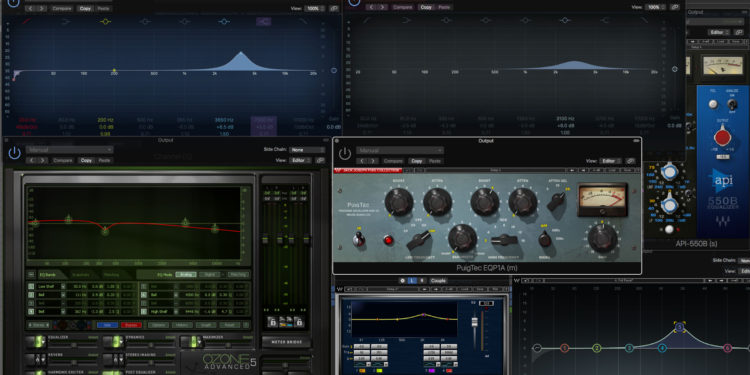5 EQ Processes you might be doing wrong

It’s often too easy to get stuck in certain processes based on a previous mixdown, or ramping up a familiar technique to extremes, over-and-over. You can get into some bad habits. As EQ is something familiar to every producer and so easily accessible on every element of your record, it can be one of the worse offenders for being used incorrectly or inappropriately. Here are 5 things you just might be doing wrong…
1. Cutting too much low end
It’s common practice now to low-cut most track elements because of the ease of the modern DAW and visualisation of the signal. Although, low cutting is certainly a top tip in many scenarios, the over the top use of it can erode some precious harmonics that make up the body and tone of a sound, plus it’s these elements that can add body and weight to a mix. So, yes cut the mud, but be careful all that low-cut doesn’t lead to a hollow and overtly plastic sounding mix.

The top analyzer shows a tambourine sound pre-eq with a lot of low end mud. The middle shows an eq with a HPF set at 900 Hz with a 48db/octave slope. The bottom analyzer shows the sound post-eq with the lower harmonics down to 750 Hz still there and a good amount of cut but does not eat into the sound.
(Sound Clip 1 demonstrates a proper amount of cut)
(Sound Clip 2 demonstrates too much cut)
2. Boosting when you should be cutting
Think of EQ as a lot of frequency specific amplifiers and you’ll then realise that turning up sometimes isn’t the answer. Try removing the frequencies you don’t want to expose the ones you want and then boosting the overall fader / volume level. Often this can bring you a more natural result unlike boosting which will naturally impart some of the EQ’s flavour and colour on to the sound.

By cutting the Hi-Hat with the above HFP and two parametric bands, it dramatically improved the sound and made it sit better in the mix.
(Sound Clip 3 demonstrates the difference with the EQ bypassed then in)

3. Using the wrong type of EQ for the job
It’s often tempting to always use your most expensive, analogue emulating EQ software no matter what the equalization job, but there are some things worth remembering. Some EQs are designed to add colour and harmonics, some are designed for more surgical tasks. Plus, there are EQs that will introduce phase and affect the levels of a signal in different ways.
Check out the audio above to hear different EQ Types. All booting 3Khz +6dB. Starting with no EQ, then a Logic Channel EQ, then bypass, then Logic’s Linear Phase EQ, then bypass, then Waves Pultec EQP1A emulation.

4. Adding too much high end
With modern recording techniques and even budget gear being able to reproduce those sizzly high parts it’s tempting to think that really snappy, bright top-end is a polished finish. Combine this with a dulling of your hearing on long sessions and those small pushes to the +12kHz area suddenly sound lush. Mostly you want to be careful up in this frequency range, especially when talking about electronic music and the huge sound systems it’s played out on. Don’t exhaust the ears of your listener with a sizzly mix.1.
5. Detuning sounds with EQ
Sometimes you do want to boost some frequencies to use a more creative EQ curve, but do you ever find that when you boost, it sounds bad? You may be boosting frequencies that are out of tune with the key of the song. If you want to add a creative eq curve, next time figure out what key you’re in and use a handy frequency chart to boost within the key of your song. We have this reference document as a part of the FaderPro Learning Library. You can see in the below examples that even a difference of +/- 10Hz can make a big difference in the sound of a boosted EQ band.
The above synth sound is playing a C minor chord. The frequency of 660 Hz is equivalent to an E note, so when boosted it sounds very dissonant with the chord. The boost is exaggerated at 10db so you can easily hear it.
(You can hear this in Sound Clip 4, above)

However the frequency of 520 Hz is very close to an C note, the root of the C minor Chord. So when boosted it adds nice tones that fit with the chord. The boost is exaggerated at 10db so you can easily hear it.
(You can hear this in Sound Clip 5, above)
Want to learn more? Learn Check out all our FaderPro courses, taught by the biggest artists and producers in the business. Sign up now to watch free chapters and to be the first to hear about our latest courses, offers and news.









